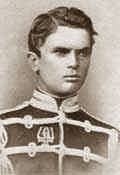|
Anton Ludwig Friedrich
August von Mackensen
(06.12.1849 - 08.11.1945)
place of birth: Kreis
Wittenberg (Prussian Saxony)
Königreich
Preußen: OBH, Generaladjutant SM,
Generalfeldmarschall (Kav)
One of Imperial Germany's most successful
field commanders during the Great War, this future
field marshal was born on 6 December into the
family of land agent Ludwig von Mackensen, said to be of Scots
ancestry, and his wife Marie Rink. Per his father's wishes, young
August first studied agriculture in Halle, but then entered the
military at age 19 as a one-year volunteer. He stayed on and
served with distinction during the Franco-Prussian War
of 1871 as part of the elite Death's Head Hussar regiment fighting in
major battles at Beaumont, Sedan
and Orleans, and earning the Iron Cross 2nd Class.
He continued his military career as a cavalry staff officer. His
marriage in 1879 to Doris von Horn produced two daughters and three
sons; Eberhard served in Italy during the Second World War
as a divisional commander, and Hans was Germany's ambassador to Rome
during this time.
As a young officer serving in Königsberg, Mackensen found an
important mentor in the person of War Minister Verdy du Vernois.
Although he never studied at the Military Academy, Mackensen was
transferred in 1880 to the Great General Staff where he learned from
the likes of von Moltke and von Schlieffen. In 1895 Kaiser Wilhelm II
selected Mackensen as his aide-de-camp, the first commoner to serve in
this position, and four years later the Kaiser named him to the
Prussian aristocracy. In 1892 he published a significant, two volume
history of his cavalry regiment entitled "The Black Hussars." His wife
died in 1905, and 1908 saw both his promotion to general of cavalry and
his marriage to his second wife, Leonie von der Osten.
The First World War found him initially
active on the Eastern Front as commander of XVII. Corps attached to the
Eighth Army. He took part in every major conflict in the East and would
remain on that front for the war's duration. His XVII. Corps suffered
an initial humiliating defeat to the Russians (Rennenkampf) at Gumbinnen,
but they later took part in great success at both Tannenberg
and Masurian Lakes.
|

|
|
Leutnant (18 yrs) |
As commander of Army
Detachment Mackensen and the Ninth Army, he
successfully directed the siege of Warsaw and
subsequent seizure of Lodz, for which he was
awarded the Pour le Merite. His Eleventh
Army, which as part of the Army Group Mackensen-Kiev
included Austro-Hungarian units, was based in the Dunajec
sector of Galicia (1915) and successfully broke through the Russian
lines at Gorlice-Tarnow, one of the greatest
victories of the war. In June 1915, von Mackensen's troops were able to
retake the Przemysl Fortress and helped Austria
recapture the city of Lemberg (L'viv, Ukraine). He
was then received the prestigious Order of the Black Eagle
and was promoted to field marshal. He was also one of only five
recipients of the Grand Cross of the Iron Cross
(1917). Following a successful stint in Serbia, he became commander of Army
Group Mackensen-Romania (1916-18) under Falkenhayn and headed
up the defeat and military occupation of Romania, where he remained
until war's end.
After the Armistice, von Mackensen was briefly
held captive in Hungary and Salonika (Greece), returning to Germany in
1919 and retiring from the Army one year later. The field marshal then
served as a leader in the monarchist Stahlhelm
forces and later became an important figurehead for the Nazi Party,
ardently supporting Hitler. Nevertheless, as a member of the
Confessional Church (die Bekennenden Kirche) he actually spoke out for
the persecuted pastor Martin Niemöller. He was also
more loyal to the monarchy than to Nazism and defied Hitler by being
conspicuously present at Kaiser Wilhelm II's funeral. There, the last
remaining WW1-era field marshal tearfully laid his cavalry cloak over
his fallen leader's coffin. In 1945, the 95-year old field marshal
spent his final days fleeing westward with millions of refugees
escaping the onslaught of the Red Army. August von Mackensen, the last
surviving German Field Marshal from the First World War, died on 8
March in Schmiedeberg and is buried in Burghorn cemetery near Celle.
His son Hans was a Nazi diplomat, while his son Eberhard served as a
general in the Wehrmacht and was later convicted of
war crimes.
|